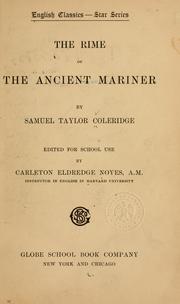Menu

The Rime of the Ancient Mariner
by Samuel Taylor Coleridge
It is an ancient Mariner, And he stoppeth one of three. By thy long grey beard and glittering eye, Now wherefore stopp'st thou me?
The Rime of the Ancient Mariner (originally The Rime of the Ancyent Marinere), written by English poet Samuel Taylor Coleridge in 1797–98 and published in 1798 in the first edition of Lyrical Ballads, is a poem that recounts the experiences of a sailor who has returned from a long sea voyage. Some modern editions use a revised version printed in 1817 that featured a gloss. The poem tells of the mariner stopping a man who is on his way to a wedding ceremony so that the mariner can share his story. The Wedding-Guest's reaction turns from amusement to impatience to fear to fascination as the mariner's story progresses, as can be seen in the language style; Coleridge uses narrative techniques such as personification and repetition to create a sense of danger, the supernatural, or serenity, depending on the mood in different parts of the poem. The Rime is Coleridge's longest major poem. It is often considered a signal shift to modern poetry and the beginning of British Romantic literature.